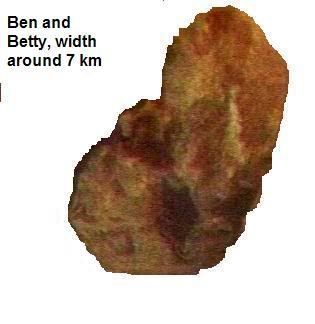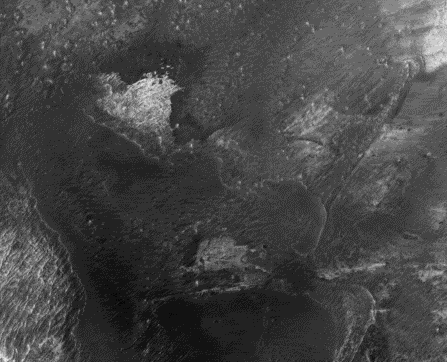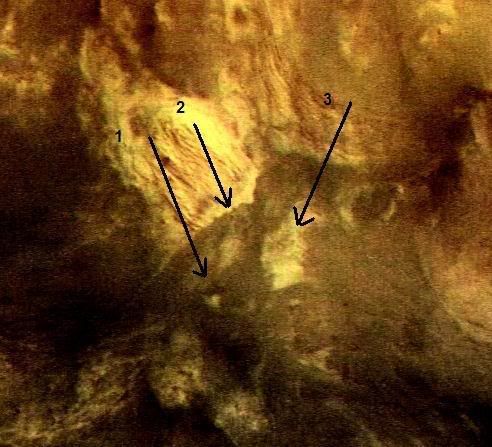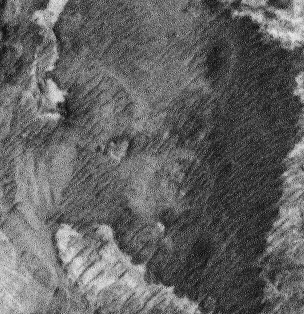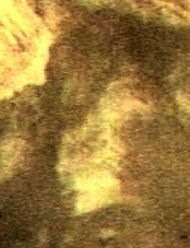- Thank you received: 0
Faces from the Chasmas
- neilderosa
-
- Offline
- Platinum Member
-

Less
More
18 years 8 months ago #17403
by neilderosa
Replied by neilderosa on topic Reply from Neil DeRosa
Before I go on to the next item I'll post a key for "Ben and Betty" with aproximate size of object.
Next is an image/mosaic posted recently. I'll post a sample for comparison.
Here's Flintstone mosaic M1700467, (also confirmed in hi-res S0500110 at 1.5 m/p). Fred is around 400 meters wide which is not unusual for faces at this scale.
Here's the ESA context with Fred (barely visible but confirmed by coordinates and surrounding landforms) indicated by arrow #1.
Arrow #2 is the realistic "Cavebear" from the same mosaic group seen in the same MOC images. S0500110 cavebear (also practically not visible in the ESA image but able to be located).
Arrow #3 is another larger scale (2-4 km wide, north oriented) face in profile left with characteristic detailed eye, upturned nose, mouth, homo sapiens chin, and good cranial development; even at this scale, shading, proportion, orientation, and detail are not neglected by the artist. In keeping with my custom of naming all faces I feel will stand up to the scrutiny that will ultimately come when the new paradigm is finally accepted, we'll call him "Howard." (Image # to be patched in later.)
Neil
Next is an image/mosaic posted recently. I'll post a sample for comparison.
Here's Flintstone mosaic M1700467, (also confirmed in hi-res S0500110 at 1.5 m/p). Fred is around 400 meters wide which is not unusual for faces at this scale.
Here's the ESA context with Fred (barely visible but confirmed by coordinates and surrounding landforms) indicated by arrow #1.
Arrow #2 is the realistic "Cavebear" from the same mosaic group seen in the same MOC images. S0500110 cavebear (also practically not visible in the ESA image but able to be located).
Arrow #3 is another larger scale (2-4 km wide, north oriented) face in profile left with characteristic detailed eye, upturned nose, mouth, homo sapiens chin, and good cranial development; even at this scale, shading, proportion, orientation, and detail are not neglected by the artist. In keeping with my custom of naming all faces I feel will stand up to the scrutiny that will ultimately come when the new paradigm is finally accepted, we'll call him "Howard." (Image # to be patched in later.)
Neil
Please Log in or Create an account to join the conversation.
18 years 8 months ago #17550
by rderosa
Replied by rderosa on topic Reply from Richard DeRosa
<blockquote id="quote"><font size="2" face="Verdana, Arial, Helvetica" id="quote">quote:<hr height="1" noshade id="quote"><i>Originally posted by neilderosa</i>
<br />In keeping with my custom of naming all faces I feel will stand up to the scrutiny that will ultimately come when the new paradigm is finally accepted, <hr height="1" noshade id="quote"></blockquote id="quote"></font id="quote">
What exactly was that paradigm, again? Most of us are missing it. Unless you're talking about finding faces in tea leaves? Don't get me wrong, I don't mean to minimize the finding of faces in tea leaves, it's just that I don't think many people know what the significance of it all is. Other than the one I've alluded to, and Fred has elaborated on.
I think it might be helpful to new readers, if you were to spell out what you think you're seeing, who did it, and what the significance of it all might be. Otherwise, it starts to get "mysterious", as in the way Trinket presents things.
rd
<br />In keeping with my custom of naming all faces I feel will stand up to the scrutiny that will ultimately come when the new paradigm is finally accepted, <hr height="1" noshade id="quote"></blockquote id="quote"></font id="quote">
What exactly was that paradigm, again? Most of us are missing it. Unless you're talking about finding faces in tea leaves? Don't get me wrong, I don't mean to minimize the finding of faces in tea leaves, it's just that I don't think many people know what the significance of it all is. Other than the one I've alluded to, and Fred has elaborated on.
I think it might be helpful to new readers, if you were to spell out what you think you're seeing, who did it, and what the significance of it all might be. Otherwise, it starts to get "mysterious", as in the way Trinket presents things.
rd
Please Log in or Create an account to join the conversation.
- neilderosa
-
- Offline
- Platinum Member
-

Less
More
- Thank you received: 0
18 years 8 months ago #17809
by neilderosa
Replied by neilderosa on topic Reply from Neil DeRosa
The importance of the <i>a priori </i>principle, in one of its strongest forms (as it pertains here) is the prediction that unseen features, once confirmed in subsequent imaging, can weigh heavily in favor of artificiality, and against such an occurrence being random, by odds of billions to one. For example; on the basis of a limited “profile” and the suggestion of a “hairdo,” I suggested that an “Observer” was standing behind the “Nurse,” in the Scullface mosaic. If, upon further imaging, the Observer was seen to possess not only secondary features, but the complete form of a face and head (previously unseen), we would have good <i>a priori </i>verification for a new figure in the Scullface mosaic, adding to the probability of artificiality of the mosaic as a whole. There are many other forms the <i>a priori </i>principle can take. One other relates to evidence of the method of construction. If we predict (as we do) that these Mars glyphs were for the most part etched into the surface of the planet, probably from above with some kind of laser equipment, evidence of such would be a fulfillment of that prediction. The same could be said for evidence of artificial coloration of the figures. There are many more examples.
Karl Popper emphasized the need for falsification (rather than the traditional verification) in scientific testing because this is necessary to disprove an hypothesis or disestablish an existing paradigm. But as Thomas Kuhn made clear, this is very difficult to do as it pertains to the latter. One might imagine from these threads that “pareidolia theory” is the established paradigm, and that the artificiality hypothesis is the revolutionary challenger. But this is not so. In fact it is not pareidolia theory as it is known and understood by science, that is being presented here. That theory was well treated in JP Levasseur’s Profile Image paper in MRB. Rather it is a new theory of elaborate, very detailed, very frequently occurring pareidolia that has been put forward, without a shred of good evidence. That is what has been presented here. But this itself is a radical new hypothesis and quite easy to falsify under strict scientific scrutiny. Conversely, many claims made here and in other threads are not falsifiable. In other words, they are to be accepted on faith, and “proof’s got nothing to do with it.”
I make the prediction that within a few hundred square kilometers of terrain of the Chasmas, that there are literally hundreds if not thousands of faces on several scales, and also other artifacts, constructed or created by intelligent beings. This is an eminently falsifiable prediction. There are several scenarios or models about what kind of beings made them, where they were from, when, and why, which have been mentioned before and won’t be gone into here, but these questions are of secondary concern. The faces range in size from between around 50 meters to 10 kilometers in breadth. I see no evidence of anything larger, and we as yet are unable to see anything smaller. Since I agree with pareidolia theory in its accepted meaning, I disagree with the idea that there are “planet wide” faces, or conversely, faces on small Mars rocks. I also maintain that each and every “face” must be proven or demonstrated on the strength of its own evidence--that, ”the devil is in the details” yes, but each face must also be evaluated by viewing it at the scale or distance from which it was meant to be seen. I agree with the model that these faces were intended to be seen from space or the atmosphere, and if there are somewhat smaller faces, (10-30 meters?) they may be for local place identification or some similar reason.
As to the strangeness of the faces, we have ample precedent for mosaics and odd looking art (to some critics) right here on earth, ranging from the works of Michelangelo, to moderns such as Picasso and Dali. So I can’t see how that aspect alone can be any basis for disqualification, although I can understand how it could upset some viewers and clash with their biases.
Neil
Karl Popper emphasized the need for falsification (rather than the traditional verification) in scientific testing because this is necessary to disprove an hypothesis or disestablish an existing paradigm. But as Thomas Kuhn made clear, this is very difficult to do as it pertains to the latter. One might imagine from these threads that “pareidolia theory” is the established paradigm, and that the artificiality hypothesis is the revolutionary challenger. But this is not so. In fact it is not pareidolia theory as it is known and understood by science, that is being presented here. That theory was well treated in JP Levasseur’s Profile Image paper in MRB. Rather it is a new theory of elaborate, very detailed, very frequently occurring pareidolia that has been put forward, without a shred of good evidence. That is what has been presented here. But this itself is a radical new hypothesis and quite easy to falsify under strict scientific scrutiny. Conversely, many claims made here and in other threads are not falsifiable. In other words, they are to be accepted on faith, and “proof’s got nothing to do with it.”
I make the prediction that within a few hundred square kilometers of terrain of the Chasmas, that there are literally hundreds if not thousands of faces on several scales, and also other artifacts, constructed or created by intelligent beings. This is an eminently falsifiable prediction. There are several scenarios or models about what kind of beings made them, where they were from, when, and why, which have been mentioned before and won’t be gone into here, but these questions are of secondary concern. The faces range in size from between around 50 meters to 10 kilometers in breadth. I see no evidence of anything larger, and we as yet are unable to see anything smaller. Since I agree with pareidolia theory in its accepted meaning, I disagree with the idea that there are “planet wide” faces, or conversely, faces on small Mars rocks. I also maintain that each and every “face” must be proven or demonstrated on the strength of its own evidence--that, ”the devil is in the details” yes, but each face must also be evaluated by viewing it at the scale or distance from which it was meant to be seen. I agree with the model that these faces were intended to be seen from space or the atmosphere, and if there are somewhat smaller faces, (10-30 meters?) they may be for local place identification or some similar reason.
As to the strangeness of the faces, we have ample precedent for mosaics and odd looking art (to some critics) right here on earth, ranging from the works of Michelangelo, to moderns such as Picasso and Dali. So I can’t see how that aspect alone can be any basis for disqualification, although I can understand how it could upset some viewers and clash with their biases.
Neil
Please Log in or Create an account to join the conversation.
- pareidoliac
-
- Offline
- Elite Member
-

Less
More
- Thank you received: 0
18 years 8 months ago #17435
by pareidoliac
Replied by pareidoliac on topic Reply from fred ressler
These images are more than art, they are also social commentary on global warming that will appear on earth, millions of years from their creation. The giant polar bear taking a bite out of the miniature earth in revenge for our melting of the ice caps is social commentary art. The "cyclops," imbedded in his heart region (to view, viewer should tilt top of her/his head to the left), only adds to the mystical art work, showing cyclops, were on earth. The slightly off center eye, of the cyclops, pre-dates Picasso by millions of years.
Please Log in or Create an account to join the conversation.
- neilderosa
-
- Offline
- Platinum Member
-

Less
More
- Thank you received: 0
18 years 8 months ago #17405
by neilderosa
Replied by neilderosa on topic Reply from Neil DeRosa
<blockquote id="quote"><font size="2" face="Verdana, Arial, Helvetica" id="quote">quote:<hr height="1" noshade id="quote">These images are more than art, they are also social commentary on global warming - pareidoliac<hr height="1" noshade id="quote"></blockquote id="quote"></font id="quote">
I believe global warming is off topic here but can be discussed on another forum in this MB; check with moderators.
I neglected to add in my little summary above that the ESA image of the Chasma has virtually eliminated to possibility of the "hoax thoery," due to confirmation of several anomolies (however poorly resolved in the ESA image) previously seen only in hi-res NASA/JPL/MSSS MOC images. Presumably a conspiracy to spread disinformation could not be coordinated between the separate, independent entities; except in isolated cased like the bump on Cydoni's head.
Neil
I believe global warming is off topic here but can be discussed on another forum in this MB; check with moderators.
I neglected to add in my little summary above that the ESA image of the Chasma has virtually eliminated to possibility of the "hoax thoery," due to confirmation of several anomolies (however poorly resolved in the ESA image) previously seen only in hi-res NASA/JPL/MSSS MOC images. Presumably a conspiracy to spread disinformation could not be coordinated between the separate, independent entities; except in isolated cased like the bump on Cydoni's head.
Neil
Please Log in or Create an account to join the conversation.
18 years 8 months ago #17679
by rderosa
Replied by rderosa on topic Reply from Richard DeRosa
<blockquote id="quote"><font size="2" face="Verdana, Arial, Helvetica" id="quote">quote:<hr height="1" noshade id="quote"><i>Originally posted by neilderosa</i>
<br />The importance of the <i>a priori </i>principle, in one of its strongest forms (as it pertains here) is the prediction that unseen features, once confirmed in subsequent imaging, can weigh heavily in favor of artificiality, and against such an occurrence being random, by odds of billions to one.<hr height="1" noshade id="quote"></blockquote id="quote"></font id="quote">Yes, we've all heard this many times, but it is meaningless when talking about pareidolic images. So, let me dispel this myth once and for all.
Suppose we were to acquire this image:
Now, we might get all excited because we see half a face in the circle. Ok, so we "predict" the rest of the face is there. Then, six months later, we get another image:
And much to our amazement, we find that not only is the rest of the face is there (see circle), but there are a couple more (see rectangle). We've "proved" with a billion to one odds that Martian's did it. Or did we? All we really proved was how easy it is to find faces. You see, that's the fatal flaw in the a priori theory as it pertains to pareidolia. It's a "cart before the horse" kind of thing. Even if we look in the area of the second eye, and other half of mouth and nose, to see if there is anything else that could have been the eye, it still doesn't prove anything other than the fact that faces are likely.
<blockquote id="quote"><font size="2" face="Verdana, Arial, Helvetica" id="quote">quote:<hr height="1" noshade id="quote">One might imagine from these threads that “pareidolia theory” is the established paradigm, and that the artificiality hypothesis is the revolutionary challenger. But this is not so. In fact it is not pareidolia theory as it is known and understood by science, that is being presented here....... Rather it is a new theory of elaborate, very detailed, very frequently occurring pareidolia that has been put forward, without a shred of good evidence.<hr height="1" noshade id="quote"></blockquote id="quote"></font id="quote"> I guess if one continues to ignore the evidence for one reason or another, it is possible to make this statement. But saying it, don't make it so. Just Fred's art alone blows this statement out of the water, but Mother Earth is literally teaming with proof, if one is open to looking for it, seeing it, and taking it for what it is, and imagining the correlation with the stuff being found on Mars.
Here are a couple of examples from the "Stone Faces Gazateer" website: www.mnmuseumofthems.org/Faces/index.html , and then I'll post more on the Pareidolia topic. Most of these are postcards, and have been in the public domain for so long, that I don't think I'm taking any liberties by posting them here. In any event, I credit the Stone Faces Gazateer website:
Man with Fedora:
JFK:
Old Scotchman:
Profile Rock with Jinns (I know how fond of Jinns you are):
There are literally thousands of these things all over the place. Apparently it's quite a pastime, to many people.
rd
<br />The importance of the <i>a priori </i>principle, in one of its strongest forms (as it pertains here) is the prediction that unseen features, once confirmed in subsequent imaging, can weigh heavily in favor of artificiality, and against such an occurrence being random, by odds of billions to one.<hr height="1" noshade id="quote"></blockquote id="quote"></font id="quote">Yes, we've all heard this many times, but it is meaningless when talking about pareidolic images. So, let me dispel this myth once and for all.
Suppose we were to acquire this image:
Now, we might get all excited because we see half a face in the circle. Ok, so we "predict" the rest of the face is there. Then, six months later, we get another image:
And much to our amazement, we find that not only is the rest of the face is there (see circle), but there are a couple more (see rectangle). We've "proved" with a billion to one odds that Martian's did it. Or did we? All we really proved was how easy it is to find faces. You see, that's the fatal flaw in the a priori theory as it pertains to pareidolia. It's a "cart before the horse" kind of thing. Even if we look in the area of the second eye, and other half of mouth and nose, to see if there is anything else that could have been the eye, it still doesn't prove anything other than the fact that faces are likely.
<blockquote id="quote"><font size="2" face="Verdana, Arial, Helvetica" id="quote">quote:<hr height="1" noshade id="quote">One might imagine from these threads that “pareidolia theory” is the established paradigm, and that the artificiality hypothesis is the revolutionary challenger. But this is not so. In fact it is not pareidolia theory as it is known and understood by science, that is being presented here....... Rather it is a new theory of elaborate, very detailed, very frequently occurring pareidolia that has been put forward, without a shred of good evidence.<hr height="1" noshade id="quote"></blockquote id="quote"></font id="quote"> I guess if one continues to ignore the evidence for one reason or another, it is possible to make this statement. But saying it, don't make it so. Just Fred's art alone blows this statement out of the water, but Mother Earth is literally teaming with proof, if one is open to looking for it, seeing it, and taking it for what it is, and imagining the correlation with the stuff being found on Mars.
Here are a couple of examples from the "Stone Faces Gazateer" website: www.mnmuseumofthems.org/Faces/index.html , and then I'll post more on the Pareidolia topic. Most of these are postcards, and have been in the public domain for so long, that I don't think I'm taking any liberties by posting them here. In any event, I credit the Stone Faces Gazateer website:
Man with Fedora:
JFK:
Old Scotchman:
Profile Rock with Jinns (I know how fond of Jinns you are):
There are literally thousands of these things all over the place. Apparently it's quite a pastime, to many people.
rd
Please Log in or Create an account to join the conversation.
Time to create page: 0.459 seconds

